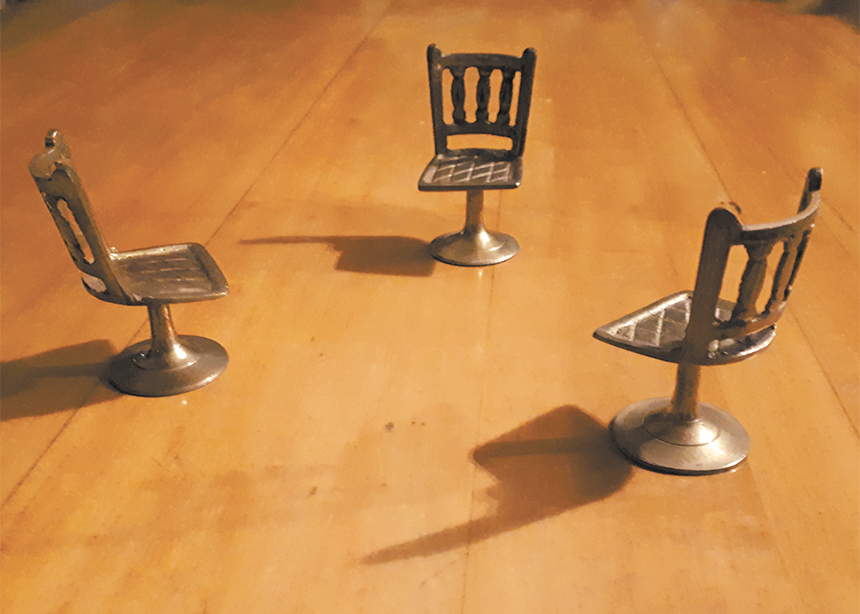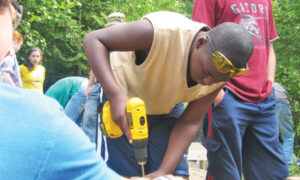When I was taking part in the Ontario Jubilee program in soul care and spiritual direction, one of the principles that guided our time together was that everything we did as a whole group happened in a circle. While some of the focal elements at the centre of our circle changed with the themes of our gatherings, two remained constant: a lamp representing the presence of God, and a cluster of three small, toy chairs representing the nature of the ministry we were learning.
Three chairs, clustered together, facing inward illustrate much of the nature of the listening ministry that is often called spiritual direction. Other terms used to describe the ministry are spiritual companionship, friendship or guidance, tending the soul, and holy or sacred listening. They all refer to an ancient and contemporary ministry that cultivates awareness of God’s activity in our lives, and offers tools and prayer practices to encourage spiritual growth.
In this ministry, a spiritual director meets regularly with a directee or client, for a series of conversations, usually every four to six weeks for about an hour each time. It is an intentional time of paying attention to the presence of God in the life of the directee. Unlike other listening ministries, such as pastoral care or counselling, spiritual direction is not usually problem-oriented. It is not so much about identifying and understanding an issue, and then working to find a solution or a coping strategy. Instead, spiritual direction is an ongoing conversation focusing on the client’s relationship with God.
So what do the three chairs represent?
Sharing in a sacred space
One of the three chairs represents the directee, or client, who is seeking support on their spiritual journey. In a sacred space of trust and confidentiality, the directee is invited to pay attention to their relationship to God. They might:
- Explore their images of God and how those have impacted them over time.
- Describe the different ways they try to pray and connect to God.
- Share moments of joy, delight, gratitude and hope, when God seems near and God’s invitations seem clear; or times when they feel spiritually dry, stuck, and distant from God.
- Try to describe encounters with God, and what those encounters mean to them.
- Bring questions, doubts, struggles and fears related to their spiritual journey.
- Bring significant questions for discernment around vocation and discipleship, meaning and purpose, relationships, and life changes.
While conversations centre on a person’s spiritual journey, it is inevitable that other life experiences will surface too, such as grief, loss and shame, relationships, family dynamics, and work and its connection to meaning and purpose. In spiritual direction, though, the conversation always returns to how God was experienced and how God might be calling us to grow in that part of life.
Sometimes a directee needs to process how their relationship to God and the church is changing. If they have had difficult, or even abusive, experiences within the church, they need a safe and confidential place to address that pain and its spiritual consequences.
Depending on what arises, spiritual directors do refer directees to other counselling and therapy services, when needed.
In spiritual direction, directees are invited to explore who they are as their truest self, assured that, at their deepest core, there is the image and likeness of God. They can also be invited to identify the ways in which they might have constructed false selves to project a good impression or to cope in certain situations, and then begin to put those aside in order to come home most fully to their truest identity as a child of God. With care and sensitivity, directors can encourage their directees to examine barriers in their spiritual life that block, distract or interfere with their ability to notice the presence of God in their life.
In each session, the invitation to the directee is always to notice where God has been present and active, and to grow more fully into the person that God is calling them to be.
Listening in three directions
The second chair represents the spiritual director—the one who is listening in three directions:
- Out, to their client.
- Up to God.
- In, to notice their own responses.
It is the director’s responsibility to create an atmosphere of hospitality and safety. Directors listen to the directee’s story, make observations and ask questions without judgment or criticism. They can help a client name and find language for stories of divine encounter. Sometimes they suggest “homework,” like journalling, spiritual reading or exploring a particular prayer practice.
The director listens for how the Holy Spirit might be at work with the directee. It is important for the director to be centred and grounded in the love of God, and tuned in to how the Spirit might nudge, prompt and lead in the conversation and in the quiet spaces. What images or metaphors are evoked as they listen, that could help the directee make sense of their story? What biblical stories or characters come to mind that could relate to their experience? Where might the Spirit be nudging new growth? How could the Spirit be challenging unhealthy patterns?
The director also does inward listening, paying attention to whatever is arising for them when they are listening to someone else. What memories and feelings are evoked as they listen? Does anything the client says trigger a particular response? Is their ego tempted to jump in and be heard, or take over and shift the conversation to their own agenda? What if their own questions and doubts arise? Does what the directee says resonate or clash with their own experience and understandings?
Whatever arises within might be important material to take into their own prayer time and into a conversation with their own spiritual director for reflection and discernment. Attending to their own relationship with God better equips them to listen well to the story of another person.
The Holy Spirit as spiritual director
The third chair is a reminder that the real spiritual director is the Holy Spirit, and the participants trust that God is present and at work everywhere, and in each life. God is made known to people in many ways. Spiritual directors help people notice and respond to the movement of God in their lives by intentionally inviting God into the conversation. Pointing to, and bearing witness to, the activity of God in another is a sacred opportunity.
Biblical texts and stories can help to centre and ground the practice in God’s Spirit. Wendy Miller in her book Jesus, Our Spiritual Director, shows how Jesus offered “soul care” to individuals, families, small groups and crowds. He was open and hospitable, listened well without judging, and he called people to respond.
Miller points out a rhythm Jesus established with his disciples as described in Mark 3:13-19. He invited them to come away with him to a quiet place, to spend time with him while he named them and sent them out to practise what they had learned and experienced. This intentional rhythm shows how the practice of spiritual direction, centred in Jesus, inspires and motivates actions, and how actions and life experiences provide the materials to bring into spiritual direction for sharing, reflection and discernment. God is present in all of that cycle of learning and living.
Spiritual direction can also happen in a small group, as it often did with Jesus and his disciples. Sharing with others can be a time of encouragement, learning, growth and inspiration. During the long months of pandemic isolation, members of the Mennonite Spiritual Directors of Eastern Canada network met regularly on video calls to pray, reflect, share, inspire and encourage one another. This was a rich experience that helped equip them to support the many people searching for spiritual guidance in such strange times.
Whether individually or in small groups, spiritual directors offer a variety of ways for people to invite God into the conversation. This could include designing and leading retreats; or using art, music and journaling to help clients deepen their relationship with God. It might include inviting clients to use their bodies by getting outside in nature to garden, run, walk, hike or canoe, and reflect on how those experiences put them in touch with themselves and with God through the window of the natural world.
In all of these ways, and more, spiritual direction can help people to deepen their relationship with themselves and with God, and to be formed more and more into the likeness of Christ, so that Christ’s love flows through them to others.
The circle of three chairs is a dynamic space where the gift of listening opens people to the moving of the Spirit.
Janet Bauman is a member of the Mennonite Spiritual Directors of Eastern Canada, a network offering individual and small group spiritual direction, contemplative retreats, prayer guides and resourcing for congregations. It is a partner organization of Mennonite Church Eastern Canada. Visit mennospiritualdirectors.weebly.com.
For discussion
1. Other than the family dinner table, what are some occasions where you have been in a circle of people? What does the circle represent to you? What are some factors that can make a circle sacred space? In what situations can it be intimidating?
2. Janet Bauman describes spiritual direction as a tool for spiritual growth. Can you imagine yourself sharing with someone your deepest thoughts and questions about your spiritual journey? What kinds of people would find spiritual direction appealing? Who might find it unattractive?
3. Bauman writes, “Spiritual directors help people notice and respond to the movement of God in their lives by intentionally inviting God into the conversation.” Why is it important to consider God’s role in all aspects of our lives? What things keep us from seeing clearly in the spiritual dimension?
4. What training do you think is most important for spiritual directors? Why is it important for the spiritual director to do inward listening as they hear another person’s stories and reflections?
5. Bauman says there are many ways to get in touch with ourselves and with God. Which of her suggestions speak to you? What is a practice that brings you close to God?
—By Barb Draper










Leave a Reply
You must be logged in to post a comment.